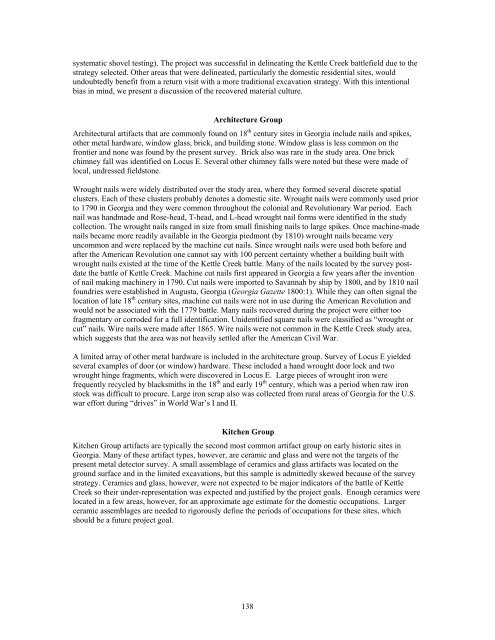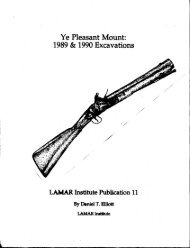Stirring Up a Hornet's Nest: - UGA Laboratory of Archaeology ...
Stirring Up a Hornet's Nest: - UGA Laboratory of Archaeology ...
Stirring Up a Hornet's Nest: - UGA Laboratory of Archaeology ...
You also want an ePaper? Increase the reach of your titles
YUMPU automatically turns print PDFs into web optimized ePapers that Google loves.
systematic shovel testing). The project was successful in delineating the Kettle Creek battlefield due to the<br />
strategy selected. Other areas that were delineated, particularly the domestic residential sites, would<br />
undoubtedly benefit from a return visit with a more traditional excavation strategy. With this intentional<br />
bias in mind, we present a discussion <strong>of</strong> the recovered material culture.<br />
Architecture Group<br />
Architectural artifacts that are commonly found on 18 th century sites in Georgia include nails and spikes,<br />
other metal hardware, window glass, brick, and building stone. Window glass is less common on the<br />
frontier and none was found by the present survey. Brick also was rare in the study area. One brick<br />
chimney fall was identified on Locus E. Several other chimney falls were noted but these were made <strong>of</strong><br />
local, undressed fieldstone.<br />
Wrought nails were widely distributed over the study area, where they formed several discrete spatial<br />
clusters. Each <strong>of</strong> these clusters probably denotes a domestic site. Wrought nails were commonly used prior<br />
to 1790 in Georgia and they were common throughout the colonial and Revolutionary War period. Each<br />
nail was handmade and Rose-head, T-head, and L-head wrought nail forms were identified in the study<br />
collection. The wrought nails ranged in size from small finishing nails to large spikes. Once machine-made<br />
nails became more readily available in the Georgia piedmont (by 1810) wrought nails became very<br />
uncommon and were replaced by the machine cut nails. Since wrought nails were used both before and<br />
after the American Revolution one cannot say with 100 percent certainty whether a building built with<br />
wrought nails existed at the time <strong>of</strong> the Kettle Creek battle. Many <strong>of</strong> the nails located by the survey postdate<br />
the battle <strong>of</strong> Kettle Creek. Machine cut nails first appeared in Georgia a few years after the invention<br />
<strong>of</strong> nail making machinery in 1790. Cut nails were imported to Savannah by ship by 1800, and by 1810 nail<br />
foundries were established in Augusta, Georgia (Georgia Gazette 1800:1). While they can <strong>of</strong>ten signal the<br />
location <strong>of</strong> late 18 th century sites, machine cut nails were not in use during the American Revolution and<br />
would not be associated with the 1779 battle. Many nails recovered during the project were either too<br />
fragmentary or corroded for a full identification. Unidentified square nails were classified as “wrought or<br />
cut” nails. Wire nails were made after 1865. Wire nails were not common in the Kettle Creek study area,<br />
which suggests that the area was not heavily settled after the American Civil War.<br />
A limited array <strong>of</strong> other metal hardware is included in the architecture group. Survey <strong>of</strong> Locus E yielded<br />
several examples <strong>of</strong> door (or window) hardware. These included a hand wrought door lock and two<br />
wrought hinge fragments, which were discovered in Locus E. Large pieces <strong>of</strong> wrought iron were<br />
frequently recycled by blacksmiths in the 18 th and early 19 th century, which was a period when raw iron<br />
stock was difficult to procure. Large iron scrap also was collected from rural areas <strong>of</strong> Georgia for the U.S.<br />
war effort during “drives” in World War’s I and II.<br />
Kitchen Group<br />
Kitchen Group artifacts are typically the second most common artifact group on early historic sites in<br />
Georgia. Many <strong>of</strong> these artifact types, however, are ceramic and glass and were not the targets <strong>of</strong> the<br />
present metal detector survey. A small assemblage <strong>of</strong> ceramics and glass artifacts was located on the<br />
ground surface and in the limited excavations, but this sample is admittedly skewed because <strong>of</strong> the survey<br />
strategy. Ceramics and glass, however, were not expected to be major indicators <strong>of</strong> the battle <strong>of</strong> Kettle<br />
Creek so their under-representation was expected and justified by the project goals. Enough ceramics were<br />
located in a few areas, however, for an approximate age estimate for the domestic occupations. Larger<br />
ceramic assemblages are needed to rigorously define the periods <strong>of</strong> occupations for these sites, which<br />
should be a future project goal.<br />
138










